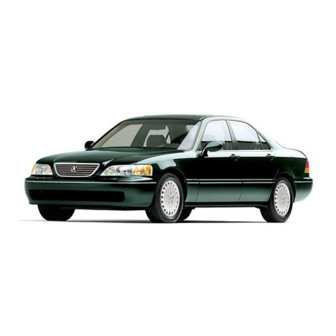
Table of Contents
Advertisement
Quick Links
1996–04 3.5RL Main Menu
General Info
Specifications
Maintenance
*Engine Electrical
Engine
Cooling
Fuel and Emissions
*Transaxle
Steering
Suspension
*Brakes (Including ABS,
TCS and VSA)
*Body
*Heating, Ventilation and
Air Conditioning
*Body Electrical
*Restraints
As sections w/ * include SRS components,
special precautions
are required when servicing.
Advertisement
Chapters
Table of Contents
Troubleshooting
















Need help?
Do you have a question about the 3.5 RL and is the answer not in the manual?
Questions and answers
How to replace the trunk lock mechanism
To replace the trunk lock mechanism on an Acura 3.5 RL:
1. Use a small screwdriver to press the inside hook down through the access hole.
2. While pressing the hook, pry the trunk handle up with a flat-tip screwdriver to remove it.
3. Remove the key cylinder from the cover.
4. Install the new key cylinder by reversing the removal steps. Ensure:
- The two trunk handles are properly put together before installing them on the trunk pass-through cover.
- The trunk pass-through cover opens properly and locks securely.
Adjust the trunk lid if necessary after installation:
- Loosen each bolt slightly.
- Adjust the trunk lid hinges right, left, fore, and aft using the elongated holes.
- Turn the trunk lid edge cushions to make the trunk lid fit flush with the body.
- Move the striker to adjust the fit between the trunk lid and the opening.
- Tighten all bolts securely.
This answer is automatically generated
How do I reset the tilt position sensor? I repaired the broken gears, but I can't activate the motor.
To reset the tilt position sensor (steering angle sensor) on an Acura 3.5 RL, follow these steps:
1. Connect the SCS service connector to the service check connector (2P) under the glove box.
2. Turn the ignition switch to ON (II).
3. Press the VSA off switch twice before the VSA activation indicator comes on again.
4. The VSA activation indicator will come on for 0.3 seconds, indicating the sensor has been reset.
This answer is automatically generated
2000 acura rl code P1486